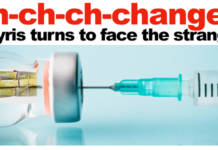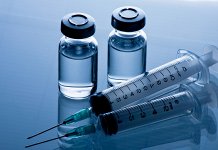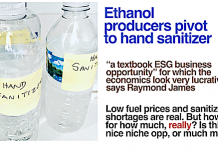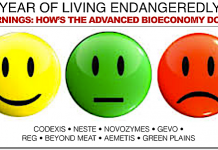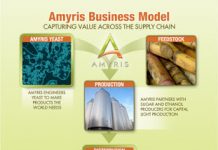by Debra Fiakas
 Management of sustainable chemical developer BioAmber (BIOA: NYSE; BIOA: TSX) have not been feeling much love from the capital markets. The BioAmber team just wants some consideration for its proprietary platform for production of bio-based succinic acid. Historically succinic acid has been produced from fossil fuel and sold as an intermediate input for use in drug compounds, agriculture and food production. BioAmber has fine tuned a fermentation process to transform organic materials such as dextrose sugars into a bio-succinic acid.
Management of sustainable chemical developer BioAmber (BIOA: NYSE; BIOA: TSX) have not been feeling much love from the capital markets. The BioAmber team just wants some consideration for its proprietary platform for production of bio-based succinic acid. Historically succinic acid has been produced from fossil fuel and sold as an intermediate input for use in drug compounds, agriculture and food production. BioAmber has fine tuned a fermentation process to transform organic materials such as dextrose sugars into a bio-succinic acid.BioAmber’s woes began last fall when the New York Stock Exchange sent the company a notice of non-compliance with NYSE listing requirements. BIOA shares had slipped below the required $1.00 level for more than thirty days. Things took a particularly chilly turn this Valentine Day week when the Toronto Stock Exchange informed the company it was beginning an expedited review of BIOA continued listing on that exchange.
No Bro-mance in Sustainable Chemicals
Notably there could be a bit more respect for BioAmber’s accomplishments in its own boardroom. A year ago the company’s chief executive officer and president, Jean-Francois Huc, resigned purportedly for personal reasons. However, Huc remained on the board of directors and continued to work in an advisory capacity. Huc’s departure began a round of musical chairs that has left the company with a number of new faces around the table. The company’s chief operating officer, Fabrice Orecchioni, was pressed into service as president and an executive search effort was commenced to find a new CEO.
The search produced chemicals industry veteran, Richard Eno. He had been in the CEO post at Metabolix where he presided as CEO over the development of bio-degradable polymers and renewable chemicals. Altogether he has over three decades experience in the energy, chemicals and materials industries. Eno took the helm directly after the warning from the NYSE and promptly got more disconcerting news from the company’s COO and recently appointed president, Orecchioni. Following in Huc’s steps, Orecchioni submitted his resignation and grabbed a six-month advisory contract.
When Relationships Sour
Perhaps Orecchioni just did not want to face investors with financial results for the third quarter ending September 2017. The company has yet to scale up to the point that revenue covers production costs, so shareholders are accustomed to red ink in BioAmber’s financial reports. Yet most investors want to hear about progress toward profitability.
The company managed to sell $3.3 million of its bio-succinic acid in the September 2017quarter, but that was less than the same quarter in the previous year and well under the June quarter record of $4.1 million. Even worse cost of goods shot up to 181% of sales in the 2017 quarter compared to 135% in the prior-year period. Still Orecchioni should not have been embarrassed by overall results as cash required to support operations had been reduced to $24.5 million in the first nine months of 2017, compared to $33.1 million in the same nine months in the previous year. Perhaps he was just a bid chagrined that the improvement was largely the result of massaging working capital accounts and no real reduction in the cash burn.
At least Orecchioni got to do a victory lap in August 2017, for the purchase of the minority partner’s 39% stake in the Sarnia, Ontario production facility. BioAmber paid CAD$1.0 million in cash and released the partner, Mitsui & Co., Ltd., from loan obligations that total CAD$15.5 million (US$20 million). Mitsui is continuing as a distribution point for BioAmber’s bio-succinic acid in Asia. The consolidation move should allow BioAmber to claim all profits as from production. The company seemingly gets the best of both worlds: flexibility to go out and find other strategic partners while retaining Mitsui as a distributor.
Control over the production facility made a great deal of sense, especially after the robust revenue reported in the June 2017 quarter. So much sense, that BioAmber handily raised $11 million in new capital in the days following report of all that promising news. The company sold 14.7 million shares of common stock at $0.75 per share. Each share came with a five-year warrant attached with an equal exercise price.
Apparently, that is where all good news and good sense ended. By the opening of the New Year 2018, BioAmber’s recently hired CEO was in talks with the company’s senior lenders. Although there were pronouncements of standing by BioAmber in its next phase of growth, in the final agreement there was little love for BioAmber to be found. True enough, the lenders agreed to water down financial covenants and waived all the violations that had occurred under the existing loan agreements. However, BioAmber had to agree to submit weekly reports on its operations and monthly financial reports. Payments to subordinated lenders were postponed and senior management agreed to forego pay raises and bonuses.
Splitting with Exchange Listings
Perhaps encouraged by the last successful sale of common stock, BioAmber attempted another capital raise at the beginning of February 2018. On February 6, 2018, pricing was announced for an underwritten public offering of 40 million common stock and warrant units at $0.25 per share for Series A units. Another Series B was sold at $0.24 per unit consisting of one share of common stock and one pre-funded warrant. The company expected to raise as much as $10 million through the deal, but was forced to take an alternative route when its underwriter backed out of the transaction due to a suspension in trading of BIOA shares on the New York Stock Exchange.
Frozen out of a public transaction, BioAmber worked with its underwriter to effect a private placement in multiple series of common stock and warrants, exercisable at $0.15 and $0.149 per share. The private offering raised a total of $7.0 million from institutional investors who were willing to accept a possible fall from grace with the stock exchanges. The company did not present the recent private placement plans to the Toronto Stock Exchange, prompting the investigation and notice of possible delisting.
A Way Forward
BioAmber may have more important things to occupy its time than stock exchange listings. The company has sent what is essentially a love letter to its creditors in the form of a multi-year plan to achieve profitability. The plan discloses that the company will need $24 million to support operations in the current year 2018. The most recently completed private placement is intended to get the company to the end of the second quarter 2018. Thus shareholders may experience significantly more dilution going forward as the company raises additional capital.
Even if the stock exchanges have not been affectionate toward BioAmber, investors have been quite tolerant of dilution in their equity stakes. Most investors have kept their eyes on the big picture, which is dominated by a good sized market for bio-succinic acid. Grand View Research measured the market size for bio-succinic acid at $137 million in 2013, and estimated the market could reach $480 million by 2020. Grand View’s market estimates are dominated by industrial applications. However, recent tests on piglets suggest bio-succinic acid could gain a foothold in the animal feed market. Now there is some love!
Debra Fiakas is the Managing Director of Crystal Equity Research, an alternative research resource on small capitalization companies in selected industries. Neither the author of the Small Cap Strategist web log, Crystal Equity Research nor its affiliates have a beneficial interest in the companies mentioned herein.

